April 2024
By David A. Koplow
What should be done if it is discovered some day that a large asteroid is on an imminent collision course with Earth? In particular, should a nuclear weapon be employed to divert or destroy such a threat if no other remedies seem sufficient?
 This nightmare scenario is not now on the horizon; no one has detected any imminent massive inbound celestial body. Yet, humanity cannot take too much comfort because even the best astronomy is unable to detect all significant asteroids in adequate time to prevent their impact and because the world currently possesses only a very limited capacity for doing anything effective about these dangers.
This nightmare scenario is not now on the horizon; no one has detected any imminent massive inbound celestial body. Yet, humanity cannot take too much comfort because even the best astronomy is unable to detect all significant asteroids in adequate time to prevent their impact and because the world currently possesses only a very limited capacity for doing anything effective about these dangers.
Any potential deployment of a nuclear device in orbit or beyond and the prospect a nuclear explosion in space would face enormous political, legal, and technical obstacles. Even if the unprecedented activity were undertaken entirely for the peaceful purpose of saving humanity from a sudden extraterrestrial threat, it would be deservedly controversial and complicated. Long-standing international legal restrictions, established to preserve nuclear stability and restraint on Earth, would be severely challenged by any nuclear anti-asteroid program.
There are four main components of this scientific, political, and legal dilemma: the scope of the potential asteroid problem, the currently inadequate array of technically feasible responses, the legal and policy impediments that would apply against any possible use of a nuclear explosive device for anti-asteroid protection, and a proposed reconciliation via adaptations in existing international law.
Dodging Asteroids
There are many millions of asteroids in the solar system, of widely varying size, composition, location, and trajectory. Most of them stay safely in the main asteroid belt between the orbits of Mars and Jupiter, but as gravity, random collisions, and space weather exert chaotic influences, some asteroids adopt more widely erratic orbits, several of which could bring them uncomfortably close to Earth. An asteroid that approaches within 45 million kilometers of our planet’s orbit is categorized as a “near Earth object”; if it flies closer than 7.5 million kilometers and is larger than 140 meters in size, it is labeled a “potentially hazardous object.”1
Distressingly, a great many of these fast-flying, portentous objects remain totally undetected. NASA and its companion space agencies in other countries are engaged assiduously in the search for these celestial bodies, and hundreds of new specimens are identified each year. Additional resources, including telescopes on the ground and in space, are being deployed to enhance “space situational awareness.” Yet, asteroids are relatively small and dark on the cosmic scale, and they can be especially difficult to detect if they approach from the general direction of the sun, which obscures the efforts of Earth-based astronomers. NASA’s Jet Propulsion Laboratory maintains a vivid Asteroid Watch Dashboard, which displays tracking information about upcoming near approaches, usually several per month, identifying each asteroid’s approximate diameter and date of closest Earth proximity.2
Generally, an asteroid larger than approximately 140 meters in diameter would be regarded as capable of inflicting regional damage, afflicting thousands of square kilometers, in a collision on Earth. There are an estimated 25,000 objects of this magnitude that could come near this planet, and only about 43 percent of them have been detected and tracked. A larger asteroid, measuring a kilometer or more across, would generate catastrophic global effects, comparable perhaps to those envisioned as the abrupt “nuclear winter” climatic alterations that could be triggered by a nuclear war. Some 854 of those giants have been detected, and dozens more are suspected.3
Throughout history, substantial asteroid impacts have been a recurrent phenomenon for this planet. Most famously, during the Chicxulub event some 66 million years ago, an asteroid 10-15 kilometers in diameter crashed into what is now the Gulf of Mexico, off the Yucatan Peninsula. The catastrophic geophysical effects led to the extinction of the non-avian dinosaurs and perhaps 75 percent of all other animal and plant species living then.4
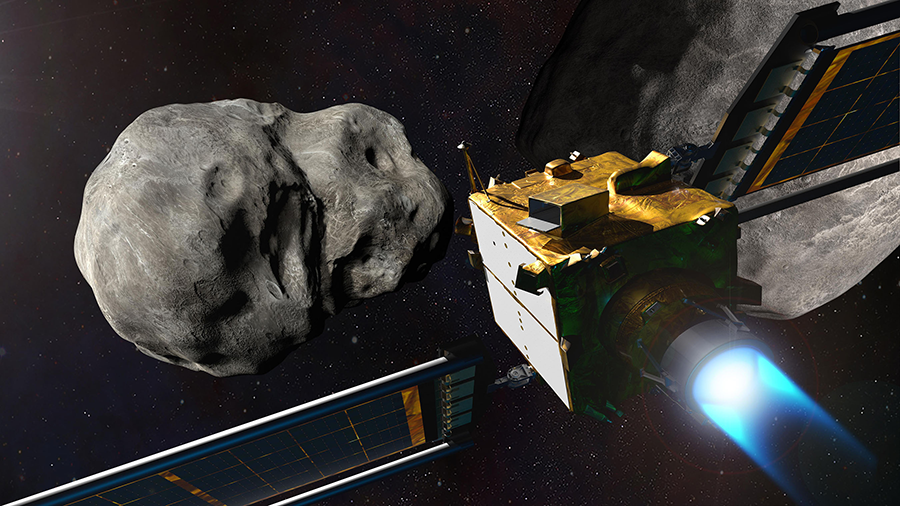 More recent episodes, involving much smaller asteroids, also have proven momentous. For example, in 1908, an asteroid perhaps 50 meters in diameter exploded above the Russian region of Tunguska. There were no documented human witnesses in that remote Siberian locale, but the force of the detonation has been estimated as equivalent to 10-50 megatons of TNT. It flattened 80 million trees over a 2,000-square-kilometer area.5
More recent episodes, involving much smaller asteroids, also have proven momentous. For example, in 1908, an asteroid perhaps 50 meters in diameter exploded above the Russian region of Tunguska. There were no documented human witnesses in that remote Siberian locale, but the force of the detonation has been estimated as equivalent to 10-50 megatons of TNT. It flattened 80 million trees over a 2,000-square-kilometer area.5
In 2013, near the Russian city of Chelyabinsk, a roughly 18-meter-wide asteroid exploded at an altitude of 30 kilometers with a yield estimated at 400-500 kilotons, damaging 7,200 buildings and injuring 1,500 people.6 No one had seen this asteroid coming, and as it streaked across the morning sky, it could have been misinterpreted as a U.S. missile.
Of course, smaller particles penetrate Earth’s atmosphere all the time, including the spectacular meteor showers that regularly illuminate the night sky. The passage of larger objects, a meter or more in size, dazzles observers somewhere on the planet three or four times per month. More ominous are the very close approaches by still-larger bodies that observatories continuously track. Although none are projected to impact Earth in the foreseeable future, these calculations remain largely a cosmic game of uncertainties and probabilities, given the difficulty of accurately projecting the future course of a distant asteroid or comet. Even if a potential threat is discerned sufficiently early, it may take many months and carefully repeated observations to determine how likely an Earth impact really is, where on the planet it might occur, and how large and solid and therefore how consequential the asteroid would be.
As one vivid example, the asteroid denominated as 99942 Apophis has a diameter of approximately 340 meters. Initial observations in 2004 indicated a 2.7 percent probability that it would collide with Earth in 2029, which would be extraordinarily damaging. Subsequent observations eliminated that possibility, but also assessed that if the 2029 flyby happened to pass within a narrow region in space characterized as a precise “keyhole,” then gravitational effects would imply that the asteroid’s next close approach to Earth, projected in 2036, would create such an impact. Subsequent additional observations have eliminated the likelihood of a collision; the 2029 conjunction will pass very near Earth, but the 2036 rendezvous will miss our planet by millions of miles, and there is now no prospect of a collision for at least the next 100 years.7
Nonetheless, other significant asteroids have replaced Apophis atop the International Astronomical Union’s Torino Scale, which categorizes asteroid impact dangers.8 In fact, between 2027 and 2029, five other, even larger asteroids will approach Earth to within only four times the distance to the moon. Ominously, astronomers warn that a doomsday collision is statistically a question of when, not whether, because large asteroids will surely collide with Earth at some point as they have in the past. They just do not know whether the next Chicxulub-scale impactor will arrive within a few decades or not for another 60 million years.
Planetary Defense
In 2016, NASA established a Planetary Defense Coordination Office, charged with leading the development of capabilities to anticipate and respond to potential asteroid perils. Several candidate technologies have been pursued, and one, the kinetic interceptor, has been operationally tested. This concept entails launching a physical mass to ram into the targeted asteroid at high speed, nudging it off its trajectory or shattering the asteroid as a last resort, much as a missile defense interceptor might attempt to do to a hostile attacker much closer to Earth.
In 2021-2022, NASA undertook the Double Asteroid Redirection Test mission, propelling a small spacecraft 11 million kilometers into the 160-meter-wide asteroid Dimorphos, which poses no threat to Earth. The program was a marvelous success, validating the ability of the craft’s autonomous guidance system to direct it unerringly to the impact point at 22,000 kilometers per hour. The asteroid’s original trajectory was indeed altered appreciably, even more than most prior calculations had anticipated.9
Nevertheless, the kinetic impactor concept has important limitations. It could succeed only against a relatively small target, a few hundred meters in size at most, and only if there was plenty of advance warning so that the small variance in the asteroid’s path could accumulate over time, causing the asteroid to miss Earth. Moreover, the scenario requires that the asteroid be a relatively solid, intact body rather than a mass of space rubble loosely held together by gravity, as some asteroids are. Additionally, the target asteroid could not be too fragile lest the impact shatter it rather than displace its course through space.
Other potential planetary defense concepts have been hypothesized and sketched out, but none has proceeded into testable hardware. One notion, the gravity tractor, would send a spacecraft to intercept an asteroid, but instead of crashing into it, the spacecraft would adopt a closely parallel flight path. As the microgravity between the two objects pulled them closer together, the spacecraft would incrementally power away, and the continuing gravity would bend the asteroid to follow, bit by bit departing from its original trajectory.10
Other even less-developed concepts would seek to install some type of engine on the asteroid or to paint it to alter the natural color and light reflectivity of one surface on the asteroid so it would differentially absorb solar energy as it spins, which could translate into slowly changing its course.
If the threatening asteroid was large, however, and if the available time frame was compressed, a more powerful response could be necessary. The attention of scientists and other experts therefore inevitably has been drawn to nuclear explosions, which offer the most efficient mechanism for transferring a large amount of energy to a distant target and represent a relatively mature technology, having been operationally tested 2,056 times, including several times in space.11
There has never been anything like a test nuclear explosion against a celestial body, but scientists have begun to contemplate some plausible methodologies. The current leading concept would not undertake to fracture the asteroid, despite several Hollywood movies luridly featuring that scenario. Doing that would probably leave most of the asteroid’s mass, which after the explosion would be highly radioactive, on a trajectory to collide with Earth. Moreover, fracturing the asteroid could create several distinct impact points on Earth, which would be comparable to a nuclear weapon with multiple independently targetable reentry vehicles and might expand the area of damage on the planet, inflicting even more harm than a single, larger crash.
Instead, a nuclear planetary defense mission likely would rely on a detonation at some short standoff distance from the asteroid and would employ the nuclear energy to vaporize volatile material on the surface of the asteroid. As those molecules rapidly evaporate or sublimate away, the resulting vapor would exert a tiny equal and opposite force, nudging the asteroid off track. Again, nothing of this sort has ever been tested, and there are no plans to undertake such an experiment.
Two relatively new international entities have emerged to study and respond to the asteroid threat. The Space Mission Planning Advisory Group is a collection of leading national space agencies, with an ambitious collective agenda to share information about asteroid exploratory missions and to collaborate to evaluate and recommend possible responses to asteroid scenarios.12 The companion International Asteroid Warning Network is an affinity group for dozens of astronomers and observatories to identify and characterize the population of potential asteroid and comet impact dangers and to serve as a clearinghouse for sharing their findings with the broader community.13
Legal Impediments
Any consideration of using nuclear detonations in space immediately inspires profound political and legal opposition.14 Three treaties or groups of treaties are implicated, each of which was created long ago for reasons having nothing to do with potential asteroid impacts. The treaties have enjoyed wide adherence and are recognized as foundational to terrestrial peace and security, but they nonetheless pose significant challenges for any nuclear planetary defense scheme.
First, under the 1963 Limited Test Ban Treaty, each party legally undertakes “to prohibit, to prevent, and not to carry out any nuclear weapon test explosion, or any other nuclear explosion, at any place under its jurisdiction or control…in the atmosphere [and] beyond its limits, including outer space.” This constitutes a direct, categorical prohibition against the contemplated nuclear planetary defense mission.
The 1996 Comprehensive Test Ban Treaty would reinforce the 1963 treaty and extend a comparable proscription to any environment, including underground, as well as in space. Although this treaty has been signed and ratified by 178 countries, it is not in force because several required countries, including the United States, have not ratified it. Its signatories are nonetheless obligated by customary international law, as reflected in Article 18 of the Vienna Convention on the Law of Treaties, “to refrain from acts which would defeat the object and purpose” of the treaty. In 2016 the UN Security Council authoritatively proclaimed that any nuclear explosion by any state would constitute such a defeat and therefore is already prohibited.15
Notably, these test ban treaties apply to nuclear weapons tests and to “any other nuclear explosion.” This explicit language ensures that even if a nuclear planetary defense operation might be characterized as a so-called peaceful nuclear explosion or “nuclear explosion for peaceful purposes,” there is no escape hatch from the legal prohibition.
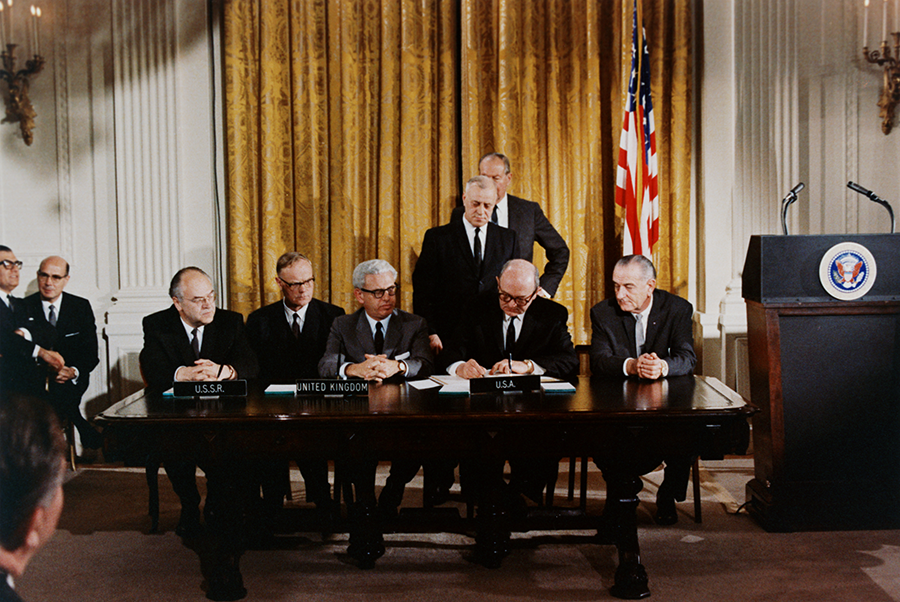 Second, the 1967 Outer Space Treaty, the foundational instrument regulating human space activities, imposes the obligation “not to place in orbit around the Earth any objects carrying nuclear weapons or any other kinds of weapons of mass destruction, install such weapons on celestial bodies, or station such weapons in outer space in any other manner.”
Second, the 1967 Outer Space Treaty, the foundational instrument regulating human space activities, imposes the obligation “not to place in orbit around the Earth any objects carrying nuclear weapons or any other kinds of weapons of mass destruction, install such weapons on celestial bodies, or station such weapons in outer space in any other manner.”
Although this treaty is sometimes cited as a comprehensive “no nukes in space” commitment, its actual coverage is narrower. It proscribes only three specified activities regarding nuclear weapons: their placement in Earth orbit, installation on a celestial body, and stationing in space. Notably, the treaty does not bar the transit of a nuclear weapon through space. Although the key terms are not defined in the treaty or in the subsequent practice by states interpreting the language, it might be possible for a nuclear planetary defense mission to adopt an operational profile that dodged these constraints. For example, the nuclear explosive device might not have to orbit the Earth even once before being directed toward its target; it might not have to be installed on the asteroid if it were detonated at a distance; and its flight plan might not be regarded as having it stationed in space.
In addition, the Outer Space Treaty language applies to nuclear weapons, and some might seek to characterize a nuclear explosive device being employed for a peaceful, planet-saving operation as not constituting a weapon. That term might be reserved most appropriately for instruments used for a hostile, warlike, or criminal purpose. Of course, many items are dual use; a knife would be regarded as a weapon if it is wielded to threaten or stab someone but not when it is used to slice an apple. The literature on this point reflects an unresolved international debate regarding the treaty’s applicability to a nuclear planetary defense mission.
Finally, the several treaties dealing with nuclear nonproliferation also could be implicated, especially if the nuclear planetary defense mission were undertaken by a coalition of countries that included some legally authorized to possess nuclear weapons and some not. The 1968 nuclear Nonproliferation Treaty (NPT), for example, prohibits parties that possess nuclear weapons from transferring to others a nuclear weapon or other nuclear explosive device or control over such a weapon, and it reciprocally prohibits non-nuclear-weapon states from receiving such a weapon or device or control over it. So, the respective roles of the various states collectively participating in a nuclear planetary defense mission would have to be precisely defined, to prohibit control passing to an unauthorized state.
Many regional treaties establishing nuclear-weapon-free zones go a significant step further in pursuit of nonproliferation, requiring their parties, in the language of the treaty applicable to Latin America, to “refrain from engaging in, encouraging or authorizing, directly or indirectly, or in any way participating in the testing, use, manufacture, production, possession, or control of any nuclear weapon.” This broad mandate would seem not only to bar a non-nuclear-weapon state from actively joining in a nuclear planetary defense mission, but also from requesting that other states undertake such a rescue or expressing political support for it. Although a nuclear planetary defense mission would have to be led by one or a handful of technologically advanced countries, it surely would be beneficial to develop a broad global consensus endorsing such an operation even if that required circumventing this legal restriction.
A similar effect could result from the ambitious scope of the 2021 Treaty on the Prohibition of Nuclear Weapons, which comprehensively bars its states-parties from possessing, testing, using, or conducting other operations regarding nuclear weapons and includes an undertaking never to “assist, encourage or induce, in any way, anyone to engage in any activity prohibited to a State Party under this Treaty.” That mandate also could inhibit any effort to generate international support for or participation in a multinational nuclear planetary defense operation.
Additionally, any future international agreement that comprehensively sought a global, permanent abolition of nuclear weapons would be challenged by the asteroid scenario. Already, opponents of the concept of creating a world free of nuclear weapons cite the possible planetary defense application as a rationale against progress toward zero.
The Search for a Solution
What should be done if a threatening asteroid appears on the horizon and the potential array of non-nuclear planetary defense options seems inadequate to the task? Is there any way to maintain international fidelity to the treaties and collective adherence to the rule of law while acting efficaciously to protect the planet?
One potential recourse would be to alter relevant treaty obligations. Each of these agreements can be amended; each is also subject to withdrawal if a party’s “supreme interests” are jeopardized. These mechanisms are somewhat cumbersome, however, and can be time-consuming; in some instances, effective amendment requires a supermajority or even unanimity among the parties. Such changes also would constitute a permanent alteration in the treaty legal obligations rather than just a temporary exception. There are also valid excuses for nonperformance of international legal obligations, known as “circumstances that preclude the wrongfulness” of the state’s action, such as duress, necessity, and fundamentally changed circumstances. Again, none of these recognized rationales seems quite applicable to the situation under consideration here.16
Another alternative, favored by an ad hoc international lawyers working group established in 2017 by NASA and the space agencies of other cooperating countries, would turn to the UN Security Council.17 Under Chapter VII of the UN Charter, the Security Council possesses an extraordinary power in the event of a declared “threat to the peace” to create new law, including the even more extraordinary power effectively to supersede the obligations of prior treaties. The council could exercise that power to authorize a particular state or combination of states to undertake a nuclear planetary defense mission, notwithstanding the preexisting obligations of the Limited Test Ban Treaty, the Outer Space Treaty, the NPT, and other instruments noted above.
In so doing, the Security Council could immunize the acting states from any adverse legal consequences that would otherwise flow from their intentional, material departure from the implicated treaties. Once sufficient facts were known, the council could tightly restrict the authority it was delegating to certain states, limiting the number and type of nuclear weapons to be used and the way in which they would be applied, the identities of the states that could be involved in the most delicate parts of the operation, the time frame, the transparency of the operation, and other parameters.
Of course, the Security Council could adopt such a resolution only pursuant to unanimity or abstention among its five veto-wielding permanent members (China, France, Russia, the United Kingdom, and the United States). If those powers cannot see eye to eye regarding this peril, then the planet truly would be jeopardized.
Other international institutions could play a supporting role in legitimizing a nuclear planetary defense mission. The UN General Assembly and its subordinate Committee on the Peaceful Uses of Outer Space, as well as the Conference on Disarmament, do not possess the inherent lawmaking powers of the Security Council. Even so, a robust debate and endorsement by those bodies could manifest a high degree of global consensus on the appropriate course of action, helping politically to excuse what could otherwise constitute material breaches of legal obligations.
The danger of a catastrophic asteroid impact has only begun to attract the type and scale of attention and resources it demands. The problem requires technical finesse and large, sustained expenditures; it is grounded in a probabilistic assessment of potential hazards rather than a finite certainty; and it exposes a time frame that stretches far beyond any politician’s term of office—all factors that create a sure formula for shoving the issue to a back burner.
The use of a nuclear weapon would not be anyone’s first choice for a planetary defense mission. The financial costs and environmental consequences would be severe, the international politics could be corrosive, the legal jeopardy to important arms control treaties would be substantial, and the breaching of a decades-long taboo against nuclear weapons use would be dreadful.
Still, this option belongs on the list of possible responses, should the worst imaginable scenario emerge. Even the most substantial international legal commitments should never pose an obstacle to action that would be truly necessary to protect the planet from Armageddon, especially when there are mechanisms that could allow the world to stave off an incoming asteroid while demonstrating fidelity to the law.
ENDNOTES
1. Center for Near Earth Object Studies (CNEOS), NASA Jet Propulsion Laboratory, “Frequently Asked Questions,” n.d., https://cneos.jpl.nasa.gov/faq/ (accessed December 16, 2023).
2. NASA Jet Propulsion Laboratory, “Asteroid Watch,” n.d., https://www.jpl.nasa.gov/asteroid-watch (accessed December 16, 2023).
3. NASA, “Near-Earth Asteroids as of November 2023,” November 2023, https://science.nasa.gov/science-research/planetary-science/planetary-defense/near-earth-asteroids/.
4. ChicxulubCrater.org, “About the Chicxulub Crater,” n.d., http://www.chicxulubcrater.org/ (accessed December 16, 2023).
5. Natalia A. Artemieva and Valery V. Shuvalov, “From Tunguska to Chelyabinsk via Jupiter,” Annual Review of Earth and Planetary Sciences, Vol. 44 (2016), p. 37, https://doi.org/10.1146/annurev-earth-060115-012218.
6. Don Yeomans and Paul Chodas, “Additional Details on the Large Fireball Event Over Russia on Feb. 15, 2013,” Center for Near Earth Object Studies, NASA Jet Propulsion Laboratory, March 1, 2013, https://cneos.jpl.nasa.gov/news/fireball_130301.html.
7. NASA, “Apophis,” n.d., https://science.nasa.gov/solar-system/asteroids/apophis/ (accessed December 16, 2023).
8. CNEOS, NASA Jet Propulsion Laboratory, “Torino Impact Hazard Scale,” n.d., https://cneos.jpl.nasa.gov/sentry/torino_scale.html (accessed December 16, 2023).
9. Johns Hopkins University Applied Physics Laboratory, “Double Asteroid Redirection Test,” n.d., https://dart.jhuapl.edu/ (accessed December 16, 2023).
10. Committee to Review Near-Earth-Object Surveys and Hazard Mitigation Strategies Space Studies Board, “Defending Planet Earth: Near-Earth-Object Surveys and Hazard Mitigation Strategies,” National Research Council, 2010, pp. 66-88.
11. Arms Control Association, “Nuclear Testing Tally,” August 2023, https://www.armscontrol.org/factsheets/nucleartesttally.
12. European Space Agency, “Space Mission Planning Advisory Group,” n.d., https://www.cosmos.esa.int/web/smpag (accessed December 16, 2023).
13. See International Asteroid Warning Network (website), December 4, 2023, https://iawn.net/.
14. See Lt. Col. John C. Kunich, “Planetary Defense: The Legality of Global Survival,” Air Force Law Review, Vol. 41 (1997), p. 119; Jan Osburg et al., “Nuclear Devices for Planetary Defense,” n.d., https://ntrs.nasa.gov/api/citations/20205008370/downloads/Nuclear_Devices_for_Planetary_Defense_ASCEND_2020
_FINAL_2020-10-02.pdf; Bryce G. Poole, “Against the Nuclear Option: Planetary Defence Under International Space Law,” Air & Space Law, Vol. 45, No. 1 (March 1, 2020): 55.
15. On September 15, 2016, the permanent members of the UN Security Council (China, France, Russia, the United Kingdom, and the United States) collectively declared that a nuclear test by any country would defeat the object and purpose of the Comprehensive Test Ban Treaty. Office of the Spokesperson, U.S. Department of State, “Joint Statement on the Comprehensive Nuclear-Test-Ban Treaty by the Nuclear Nonproliferation Treaty Nuclear-Weapon States,” September 15, 2016, https://2009-2017.state.gov/r/pa/prs/ps/2016/09/261993.htm. This determination was subsequently endorsed by the full Security Council in Resolution 2310. UN Security Council, S/RES/2310, September 23, 2016.
16. “Yearbook of the International Law Commission, 2001,” Vol. II, Pt. 2, A/CN.4/SER.A/2001/Add.1 (Part 2), 2007, pp. 71-86.
17. Space Mission Planning Advisory Group (SMPAG) Ad-Hoc Working Group on Legal Issues, “Planetary Defence Legal Overview and Assessment,” SMPAG-RP-004, April 8, 2020, https://www.cosmos.esa.int/documents/336356/336472/SMPAG-RP-004_1_0_SMPAG_legal_report_2020-04-08+%281%29.pdf/60df8a3a-b081-4533-6008-5b6da5ee2a98?t
=1586443949723. See also David A. Koplow, “Exoatmospheric Plowshares: Using a Nuclear Explosive Device for Planetary Defense Against an Incoming Asteroid,” UCLA Journal of International Law and Foreign Affairs, Vol. 23, No. 1 (Spring 2019): 76.
David A. Koplow is Scott K. Ginsberg Professor of Law at the Georgetown University Law Center, where he teaches and writes in the areas of international law and national security law. He is a member of an ad hoc legal working group established by NASA and other national space agencies to advise on the legal aspects of planetary defense.
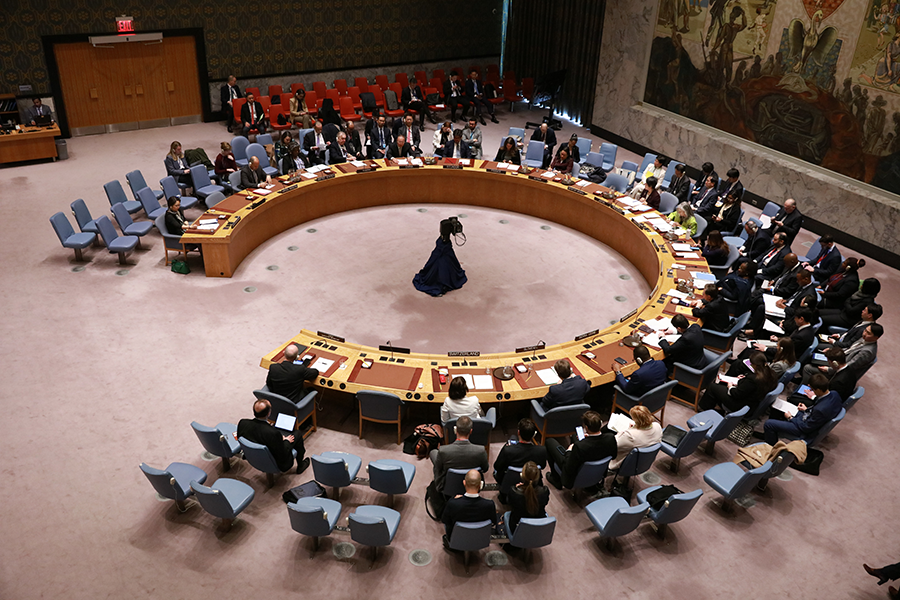 To address such challenges, UN Secretary-General António Guterres outlined several commonsense, achievable steps that could begin to move the world away from the nuclear precipice if pursued by China, Russia, the United States, and others.
To address such challenges, UN Secretary-General António Guterres outlined several commonsense, achievable steps that could begin to move the world away from the nuclear precipice if pursued by China, Russia, the United States, and others.




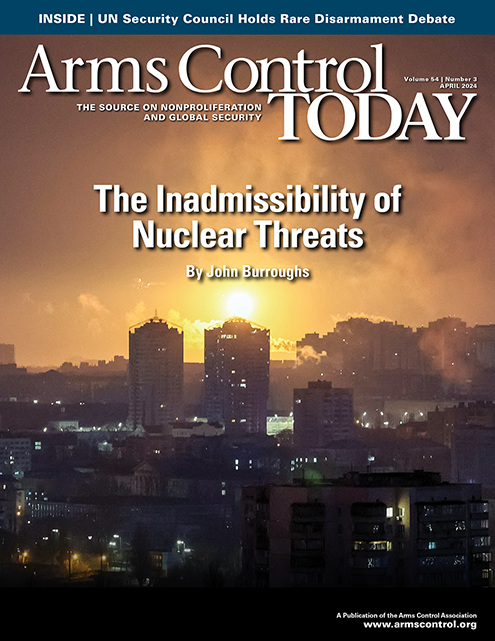
 In the summer and autumn of 2017, the United States and North Korea exchanged incendiary warnings of nuclear destruction.
In the summer and autumn of 2017, the United States and North Korea exchanged incendiary warnings of nuclear destruction.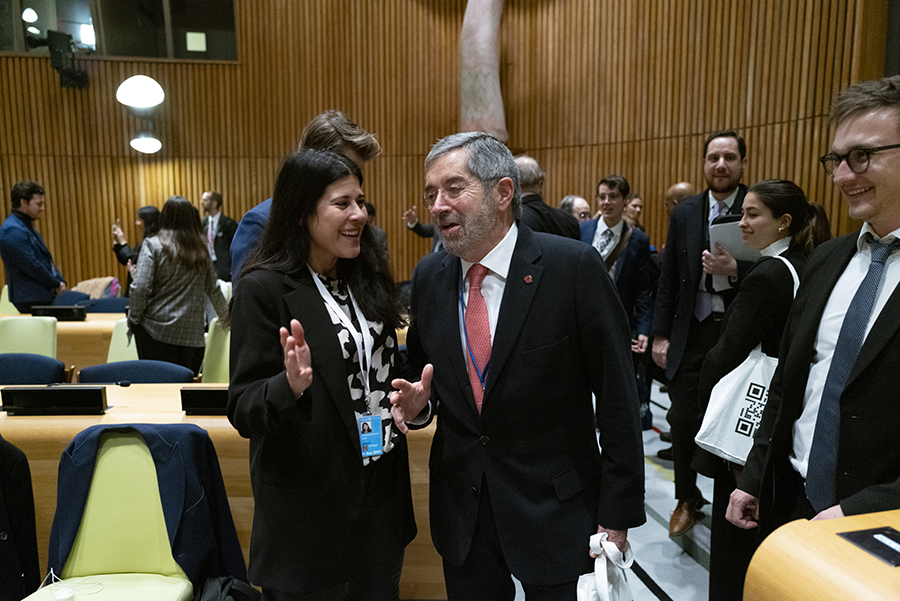 In June 2022, five months prior to the adoption of the G-20 declaration in Bali, the first meeting of TPNW states-parties adopted the Vienna Declaration. In it, states-parties “stress that any use or threat of use of nuclear weapons is a violation of international law”; and they “condemn unequivocally any and all nuclear threats, whether they be explicit or implicit and irrespective of the circumstances.” The second meeting of states-parties, in New York City in late 2023, reiterated those points. The TPNW itself obligates states-parties “never under any circumstances” to “use or threaten to use nuclear weapons.” TPNW states-parties do not include any nuclear-armed states.
In June 2022, five months prior to the adoption of the G-20 declaration in Bali, the first meeting of TPNW states-parties adopted the Vienna Declaration. In it, states-parties “stress that any use or threat of use of nuclear weapons is a violation of international law”; and they “condemn unequivocally any and all nuclear threats, whether they be explicit or implicit and irrespective of the circumstances.” The second meeting of states-parties, in New York City in late 2023, reiterated those points. The TPNW itself obligates states-parties “never under any circumstances” to “use or threaten to use nuclear weapons.” TPNW states-parties do not include any nuclear-armed states. This nightmare scenario is not now on the horizon; no one has detected any imminent massive inbound celestial body. Yet, humanity cannot take too much comfort because even the best astronomy is unable to detect all significant asteroids in adequate time to prevent their impact and because the world currently possesses only a very limited capacity for doing anything effective about these dangers.
This nightmare scenario is not now on the horizon; no one has detected any imminent massive inbound celestial body. Yet, humanity cannot take too much comfort because even the best astronomy is unable to detect all significant asteroids in adequate time to prevent their impact and because the world currently possesses only a very limited capacity for doing anything effective about these dangers. More recent episodes, involving much smaller asteroids, also have proven momentous. For example, in 1908, an asteroid perhaps 50 meters in diameter exploded above the Russian region of Tunguska. There were no documented human witnesses in that remote Siberian locale, but the force of the detonation has been estimated as equivalent to 10-50 megatons of TNT. It flattened 80 million trees over a 2,000-square-kilometer area.
More recent episodes, involving much smaller asteroids, also have proven momentous. For example, in 1908, an asteroid perhaps 50 meters in diameter exploded above the Russian region of Tunguska. There were no documented human witnesses in that remote Siberian locale, but the force of the detonation has been estimated as equivalent to 10-50 megatons of TNT. It flattened 80 million trees over a 2,000-square-kilometer area. Second, the 1967 Outer Space Treaty, the foundational instrument regulating human space activities, imposes the obligation “not to place in orbit around the Earth any objects carrying nuclear weapons or any other kinds of weapons of mass destruction, install such weapons on celestial bodies, or station such weapons in outer space in any other manner.”
Second, the 1967 Outer Space Treaty, the foundational instrument regulating human space activities, imposes the obligation “not to place in orbit around the Earth any objects carrying nuclear weapons or any other kinds of weapons of mass destruction, install such weapons on celestial bodies, or station such weapons in outer space in any other manner.”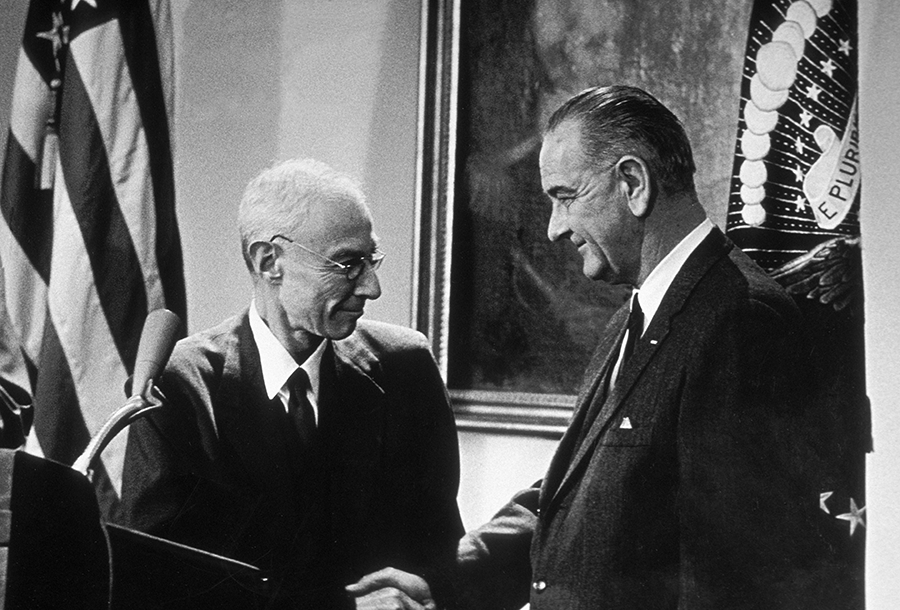 That might leave some viewers wondering how Oppenheimer hoped to prevent what he accurately foresaw as an unwinnable superpower nuclear arms race. Despite the personal struggles portrayed in the movie, he worked ceaselessly toward identifying a practical path toward that goal. Unfortunately, the answer he ultimately found has been all but forgotten.
That might leave some viewers wondering how Oppenheimer hoped to prevent what he accurately foresaw as an unwinnable superpower nuclear arms race. Despite the personal struggles portrayed in the movie, he worked ceaselessly toward identifying a practical path toward that goal. Unfortunately, the answer he ultimately found has been all but forgotten.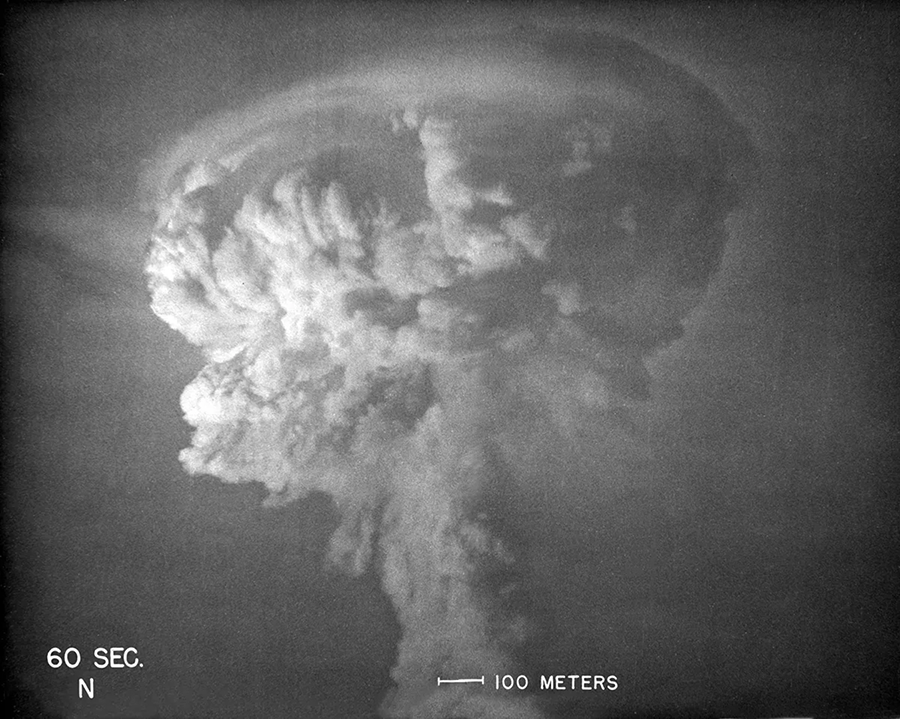 Oppenheimer then took this logic a step further. Should the day arrive when improved superpower relations revived interest in nuclear disarmament, he proposed that nationwide defenses would be a vital supplement to a verification regime. Although verification alone could not eliminate fears of hidden nuclear weapons and bombers, extensive defensive deployments could resolve that formidable obstacle to comprehensive offensive disarmament. As he explained in a 1953 article, a combination of robust verification measures and large-scale defenses could make “steps of evasion far too vast to conceal or far too small to have, in view of existing measures of defense, a decisive strategic effect.”
Oppenheimer then took this logic a step further. Should the day arrive when improved superpower relations revived interest in nuclear disarmament, he proposed that nationwide defenses would be a vital supplement to a verification regime. Although verification alone could not eliminate fears of hidden nuclear weapons and bombers, extensive defensive deployments could resolve that formidable obstacle to comprehensive offensive disarmament. As he explained in a 1953 article, a combination of robust verification measures and large-scale defenses could make “steps of evasion far too vast to conceal or far too small to have, in view of existing measures of defense, a decisive strategic effect.”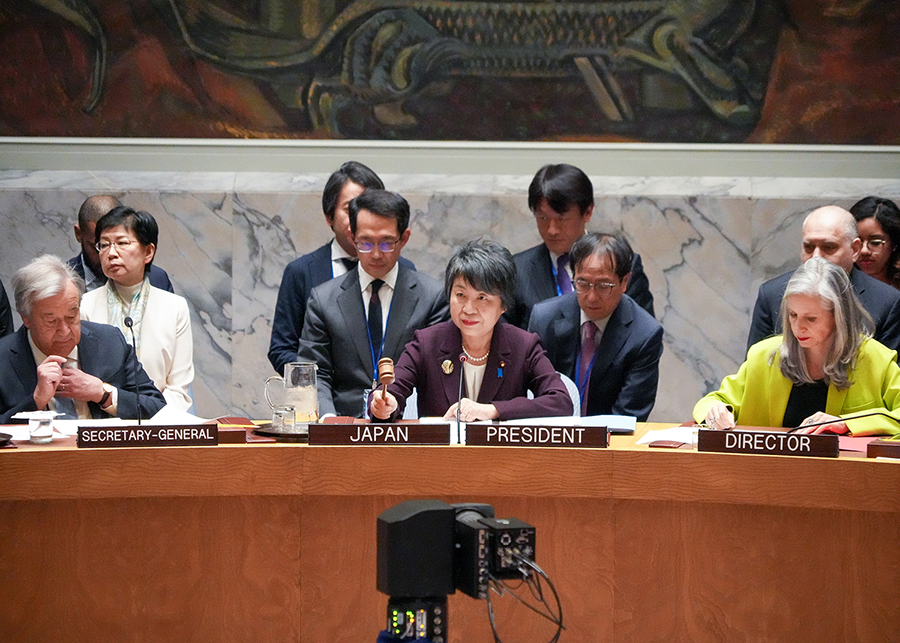 Japanese Foreign Minister Yoko Kamikawa described the meeting as “an opportunity for UN member states to share concrete ideas and proposals to accelerate the realization of a world without nuclear weapons” in an op-ed published by PassBlue on March 17.
Japanese Foreign Minister Yoko Kamikawa described the meeting as “an opportunity for UN member states to share concrete ideas and proposals to accelerate the realization of a world without nuclear weapons” in an op-ed published by PassBlue on March 17.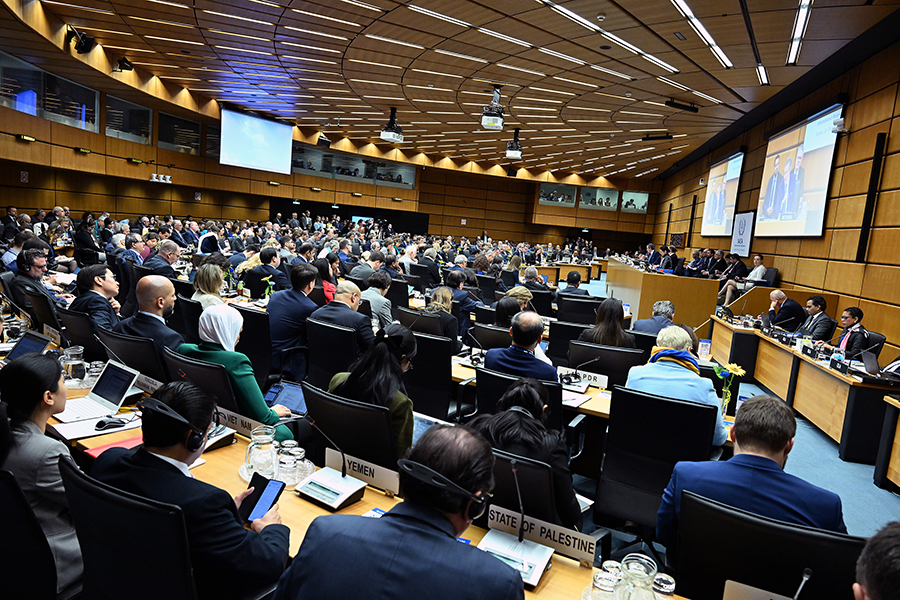 The agency has been pressing Iran for years to account for the presence of nuclear materials at two sites that were never declared to the IAEA as part of Iran’s nuclear program. The agency assesses that one of the locations, Turquazabad, was used to store nuclear materials and equipment, and the other, Varamin, included a pilot plant for uranium milling and conversion.
The agency has been pressing Iran for years to account for the presence of nuclear materials at two sites that were never declared to the IAEA as part of Iran’s nuclear program. The agency assesses that one of the locations, Turquazabad, was used to store nuclear materials and equipment, and the other, Varamin, included a pilot plant for uranium milling and conversion.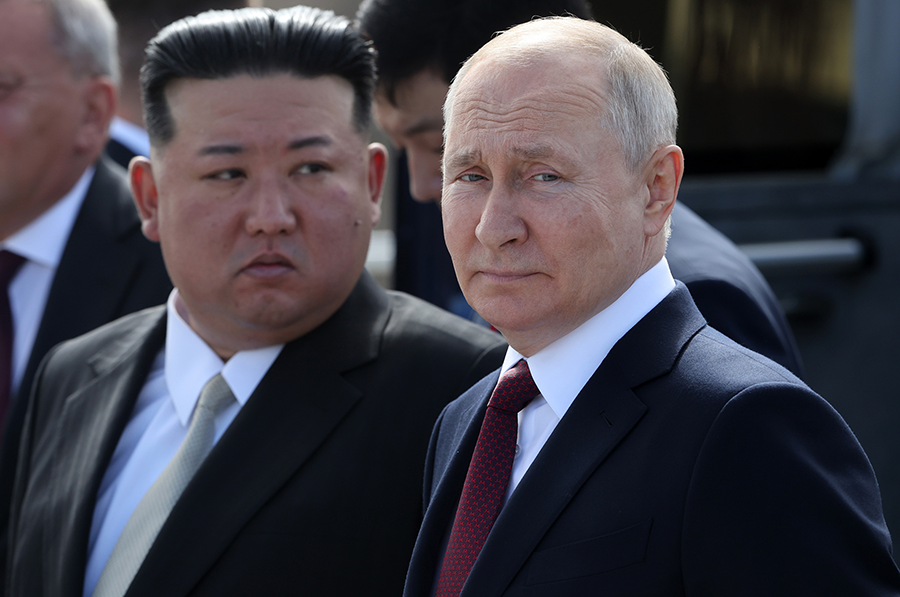 After Putin made several veiled nuclear threats in the spring and fall of 2022, U.S. intelligence officials made public an assessment that senior Russian officials had discussed the use of tactical nuclear weapons in Ukraine that year. (See
After Putin made several veiled nuclear threats in the spring and fall of 2022, U.S. intelligence officials made public an assessment that senior Russian officials had discussed the use of tactical nuclear weapons in Ukraine that year. (See 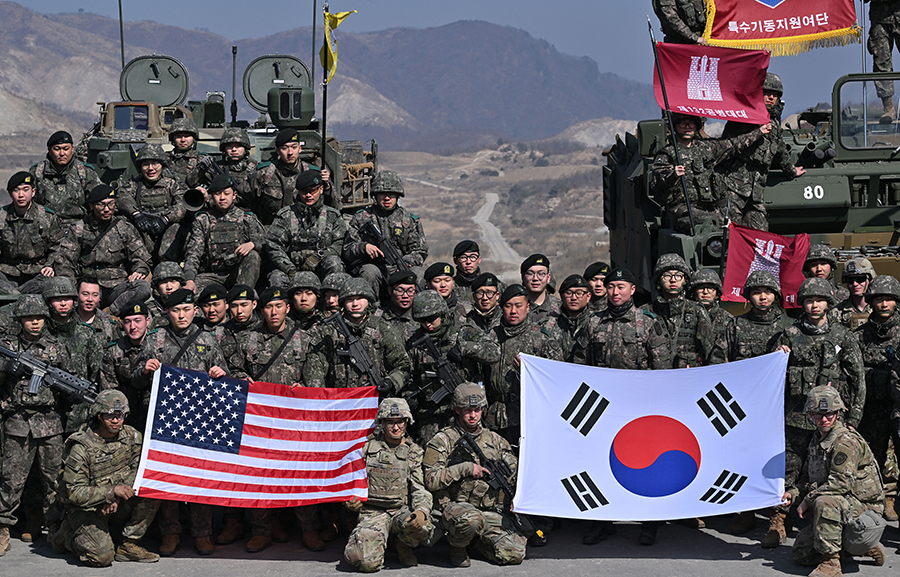 Washington still views negotiations with Pyongyang as the only viable pathway to peace on the Korean peninsula and remains focused on denuclearizing North Korea, Jung Pak, the U.S. senior official for North Korea, said March 5 at the Carnegie Endowment for International Peace.
Washington still views negotiations with Pyongyang as the only viable pathway to peace on the Korean peninsula and remains focused on denuclearizing North Korea, Jung Pak, the U.S. senior official for North Korea, said March 5 at the Carnegie Endowment for International Peace.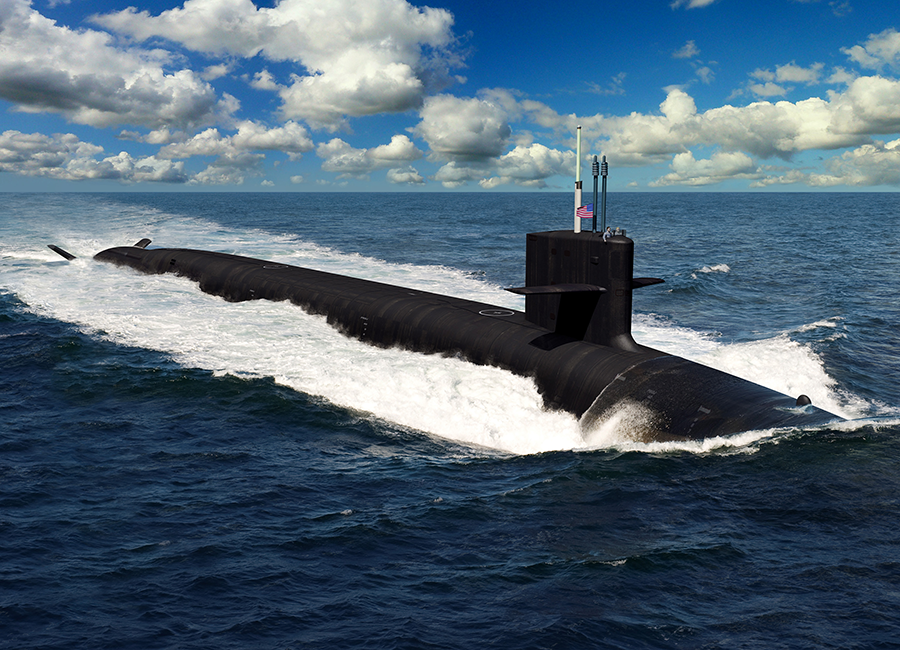 The request for National Nuclear Security Administration (NNSA) weapons-related activities is 4 percent higher than appropriated by Congress for fiscal year 2024. In all, the budget request, unveiled on March 11, calls for $69 billion for nuclear weapons operations, sustainment, and modernization, including $49 billion for Pentagon programs and the rest for the NNSA. The combined budgets would be 22 percent higher than last year.
The request for National Nuclear Security Administration (NNSA) weapons-related activities is 4 percent higher than appropriated by Congress for fiscal year 2024. In all, the budget request, unveiled on March 11, calls for $69 billion for nuclear weapons operations, sustainment, and modernization, including $49 billion for Pentagon programs and the rest for the NNSA. The combined budgets would be 22 percent higher than last year. The quickening diplomacy reflects growing worldwide concern over the faulty or unsupervised use of artificial intelligence (AI) and autonomous weapons in combat, possibly resulting in unintended atrocities or conflict escalation, and differing opinions over how best to prevent such perils.
The quickening diplomacy reflects growing worldwide concern over the faulty or unsupervised use of artificial intelligence (AI) and autonomous weapons in combat, possibly resulting in unintended atrocities or conflict escalation, and differing opinions over how best to prevent such perils.